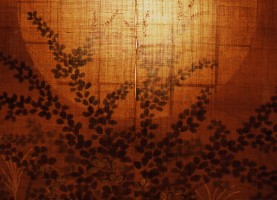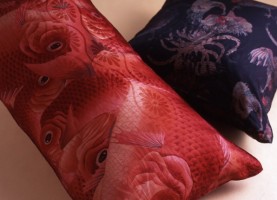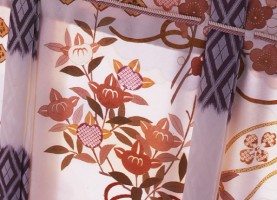

白生地に、花鳥風月などの模様を染め上げる京友禅。その華やかさは京友禅の大きな特徴です。手描友禅と型友禅に大別されますが、手描友禅は、江戸時代中期(17 世紀後半)に京都の宮崎友禅斉によって技法が大成され、友禅染の名前のもととなりました。型友禅は明治初期に京都の広瀬治助によって開発されたもので、模様を写し取った型紙を使って染める技法です。多くの工程を経てつくられる京友禅の華麗さは、わが国を代表する工芸品にふさわしいものです。
“Kyo-yuzen” is a style of textile dyeing that creates colorful patterns of natural scenes on white cloth. Characterized by the brilliant use of color, “kyo-yuzen” dyeing is accomplished by either hand dyeing or stencil dyeing. The technique of hand dyeing was developed in Kyoto during the mid-Edo Period(17th century)by Miyazaki Yuzensai, from whom the name “yuzen” dyeing was taken. Stencil dyeing was developed in Kyoto during the early Meiji Period by Hirose Jisuke. The product of numerous production processes, the beauty and elegance of Kyo-yuzen dyeing have made it one of Japan’s best-known textile arts.
絵画のような繊細さと迫力
スケール感のある手描き友禅タペストリー
Hand-painted Yuzen tapestry of the highest caliber with the vibrancy and delicacy of a painting.
着物の見えないおしゃれ「羽織の裏地」
華やかさを競った文様をインテリアに
The hidden part of a kimono’s style “Haori-jacket lining”.
A gorgeous weave for interiors.
文様をふちどる金の輝き
手描き友禅の着物をタペストリーに
A golden lustre bordering patterns.
Hand-painted Yuzen-dyed kimono for tapestries.





